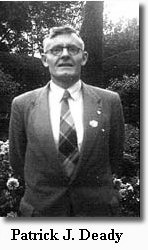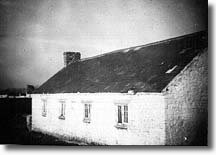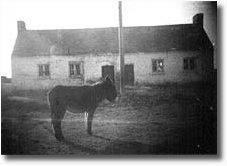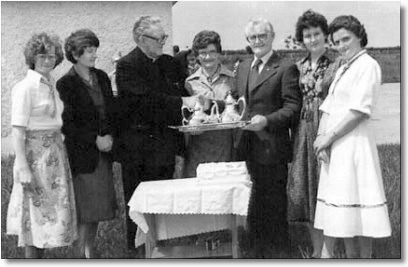
Killahan And All That.
By
Patrick J. Deady.
*
October the third 1938 found me winding my way to Killahan National School. It was a dry morning after a night of rain . As I approached the School I noticed two groups of children, boys and girls, each group gathered at the separate entrances. At that time the boys and girls were in separate rooms and amalgamation did not take place for some years after. I also noticed a pool of water outside the entrance to the boys school. That scene - the pool, the group of boys ranging from a very tall light-haired boy - Eddie Dillon - to the small infants. I had never been stared at so intently as about thirty pairs of eyes were focused like gimlets on me.
To break the tension, I said "Good morning, boys" and they replied , "Good morning, Sir" and the ice having been broken, one of them opened the narrow gate of the passageway leading to the back of the school where the entrance door was. The passageway leading to the back and separating the school from Behan's field, was narrow - about three feet wide - and having stepped across the pool of water and pushed my bicycle through it, I entered.
The scene that met my eyes was anything but pleasant - a small hard-surfaced yard surrounded by four-foot high walls , one of which separated the boys from the girls and at one end of the quadrangle was a little house that did duty for a toilet. Having parked my bicycle, I approached the door and my first impression was that it could well be opened without any key as it was very worn with holes here and there and entirely unsuitable for any building.
When I unlocked it and pushed it in , the shock I received has stayed with me still as the place was in total darkness and I was afraid to put a foot beyond the entrance lest I should fall into some abyss. There was such an atmosphere of decay surrounding the building that I feared I was endangering my life in entering at all. After a while my eyes became accustomed to the semi-darkness and I could see a floor which I tested with one foot and found that it bore me up. Then I noticed why the whole place was in darkness - there were shutters on the windows. Soon the big boys got to work as they knew their own routine and soon the shutters were removed and light was restored and I could survey the room at which I would be master for the next forty years.
By this time, Mrs Savage, the assistant teacher, arrived and after introductions and a little chat we got down to calling the rolls. Many of the names were familiar to me as I had spent four pre-school years at the home of my uncle, Den Callaghan in Killahan and the children knew this too as it was spoken of at home once the news got around that I had been appointed to Killahan school and they felt I was "one of their own". The principal teacher in the girls' school at that time was Mrs O'Riordan whose husband Micheal was principal in Abbeydorney Boys and the assistant teacher, a Miss McCarthy, who returned to her native Scartaglen after a short while and was replaced by Mrs O'Connor.
The need for a new school was obvious and very soon we started planning for it. Fr. Walsh, who was parish priest when I was appointed, passed on and Fr. Linehan came in his place and he very soon got to work. At a meeting of parents of children and house owners in the school area it was agreed that all would pay a cess according to their means. Procuring a site was a problem but after sometime a site was secured from John Cantillon. Then the real battle started with the Department of Education who demanded a local contribution of £500 which in the forties and fifties was an awful lot of money and, after all, the people had paid their cess and after holding a few whist drives, all we could raise was £325. Fr. Linehan, however, negotiated with the Department pointing out that there were very few well off people in the school district and eventually the Department yielded and the new school building went ahead. It was built by Michael Falvey in 1953 and open for occupation Sept. 1955.
In the meantime, while waiting for the new school to be built, the existing one was kept in some kind of repair by Timmy Canty, Davy Fitzgerald and Tom Halloran. The Long family who lived close by were always very helpful and often suppplied us with boiling water when our usual arrangement broke down.
The old school was built in 1857 and so it served the people for the most of one hundred years. It was knocked in 1958 and the stones drawn away by various people.
 |
 |
Previous teachers were Mr Bowler, Ned Fuller, who later came to Abbeydorney and William Lawlor. Later on, the teaching staff were Mrs Behan, Mrs Kearney, Mrs Moloney and Mrs Kennelly.
What was the origin of the name "Killahan". I have heard that it came from Cill Laithin - the church of St. Laheen; but nobody ever heard of a Saint called Laheen. A more likely source is Cill Achann - church of the plains. This is rather obvious from the position of the old church, now a ruin, at the centre of four plains. The Irish word achadh - pronounced agha - means a plain and surrounding the church we have Aghamore (the big plain), to the north west; Ahabeg (the small plain) to the north east; Ahacoora ( the pleasant fragrant plain) to the south east; and Aghacrainne(the plain of the river (rainne) to the south west. There was no Ballymacaquim in those far off days as that did not come into being until Norman times. Seeing that the church is situated where these four plains meet it is quite reasonable to believe that it means the church of the plains.
Ballymacaquim is more easy to account for. It means the home of the hunchback's son and this is how it came about. Tomas Fitzmaurice occupied the Norman castle in Listowel and afterwards extended his territory to Lixnaw. Tomas was a hunchback and was nicknamed "cam", meaning stooped. A son of his became known as mac-an-chaim and when he took possession of Aghamore in the twelfth century and built a castle there the area became known as Ballymacaquim. All this Fitzmaurice territory later became known as the Barony of Clanmaurice. Ballinclogher; the rocky or stony place. Baltovin; Bailte Finn , called after Finn Mac Cumhail, I suppose as the name suggests and this claim is strenghtened by its proximity to Ballysheen - Baile Oisin ( oisin's home); Derrevrin - Doire Bhrain, the oakwood of Bran, Finn's famous hound. This theory is very feasable as the territory from Baltovin to the Shannon was frequently occupied by the Fianna whose chief duty it was to guard the coasts of Ireland for fear of an invasion. As the Shannon was one of the chief gateways to Ireland it had Fenian Outposts placed along its banks and on into Tralee Bay. Finn often came along of course to inspect the outposts and spent many days hunting over the great stretch of land in North Kerry and so we have the place names of Baltovin , Ballysheen and Derrevrin.
Parknageragh - Field of the sheep; Ardrahan - the heathery, rushy hill, not very obvious now. Ballyhenry - called after one of the Fitzgerald clan. Rathscannel - The fort of Scannel. Cahernade - Cathair Neid - the seat or dwelling place of Neid. Kilgulbin - Church or Cill of Gulbin.
There was a family of Fitzgeralds living in Ballysheen many years ago who were known as the "Bully" Fitzgeralds and I have also known another family of Fitzgeralds who were called "Bullies" also and yet they were all very gentle people and in no way aggressive as the name would suggest. Later I was to learn that the word Bully was a corruption of the Irish word Buaile which means a dairy herd and it was the duty of these families to supply milk, butter, etc to the various Fitzgerald Castles, and so they became known as the Buaile Fitzgeralds.Fire Height comes from the Irish word Fadhair (pronounced fire) which means the twisty, winding hill.
In 1969 a souterrain was discovered in O'Dowd's farm in Ballysheen while building an outhouse. It consisted of four underground chambers, about six feet long, two feet wide at the base and about two feet high. The walls were made of small, flat slabs of limestone corbelled from the floor with large capstones completing the structure on top. Access was made by the removal of one of the capstones and one could crawl from one chamber to another. No artifacts were found nor any debris of any kind. They were used for storing food and perhaps valuables in the event of a raid. The souterrains are not visible now as they have been built over.
Patrick J. Deady. Sept. 1998.

Presentation to Patrick J. Deady on his retirement from Killahan School, June 1978 after 40 years of teaching.
L / R - Kathleen Kennelly N.T., Shelia Deady, Fr. Dan Hickey, Mrs. S. Deady, P.J. Deady, Mary Deady, Mrs. M. Moloney N.T.
 Times Past
Times Past